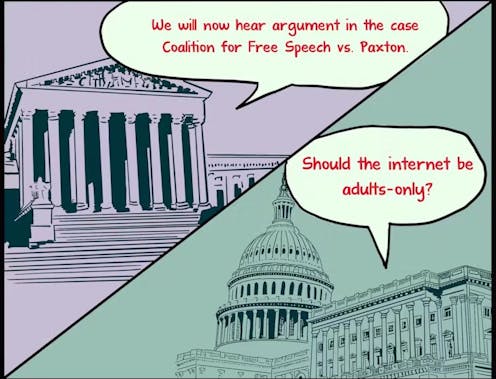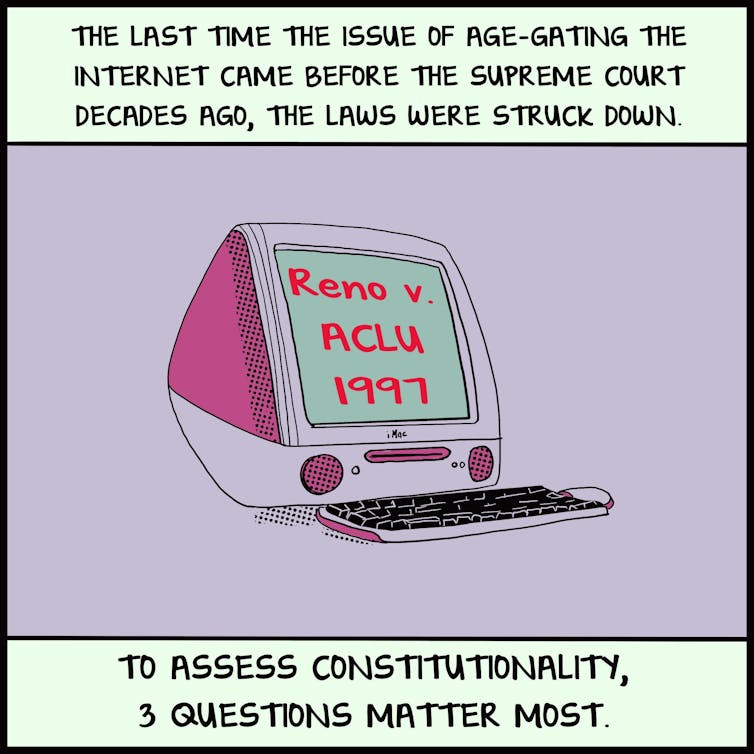
Mounting pressure to regulate children’s use of technology in the United States raises the question: Is childproofing the internet constitutional?
In response to significant political pressure stemming from alarming revelations about youth experience with digital technologies, a wave of state laws have recently passed across the U.S. They address a variety of online harms affecting children, ranging from exposure to pornography and risky content to manipulative design and social media access.
Most of the newly passed state laws have already been challenged, and those challenges are working their way up through the appeals process of the court system. In the 2024-25 term, the U.S. Supreme Court will review the constitutionality of a Texas law that obligates porn sites to block underage users in the case Free Speech Coalition v. Paxton.
The controversy found its way to the highest court after a federal district court determined that the law violated the First Amendment but the 5th U.S. Circuit Court of Appeals overturned the lower court decision. The 5th Circuit ruling compared the new law with those banning the sale of pornography magazines to minors in the 1960s, which were ruled constitutional.
While the court considers the Texas law, the U.S. House will be considering the Kids Online Safety Act, known as KOSA, and the Children and Teens Online Privacy Protection Act, referred to as COPPA 2.0, because it updates the 1998 Children’s Online Privacy Protection Act, COPPA. KOSA addresses addictive design features and parental controls, and COPPA limits data collection and use. Senate leaders merged the two into KOSPA, which passed 91-3.
Age-gating
All these laws demand that platforms treat children differently from adults, and so require platforms to know who is a child and who is an adult. This practice is referred to as age-gating and includes a few methods.
The old COPPA 1.0 added restrictions, responsibilities and liability for sites directed at kids or sites that had knowledge a user was under 13. Most sites avoid the law’s restrictions and requirements by simply including language in their terms of service forbidding those under 13 from creating an account. Others, like Facebook, eventually went further, asking the user to input their age or date of birth. Kids long ago learned to circumvent the virtually meaningless barrier.
The new wave of laws requires more, using one of two age-gating options: inference and verification. To infer age, the platforms make a good guess by using data generated by the user, either through biometric scans of the face or voice or analysis of the data troves the platforms already collect for targeted advertising. Age verification involves relying on evidence already vetted by another institution such as a government ID or credit card.
While the inference method provokes significant privacy concerns, age-gating advocates argue that age verification at the operating system or browser level is effective and doesn’t burden users or put their privacy at risk.
The last time the constitutionality of age-gating the internet came before the Supreme Court, the law did not survive. In 1997, the Supreme Court in Reno v. ACLU invalidated provisions of the Communications Decency Act enacted to protect children from exposure to explicit material online because they lacked the precision required to narrowly target unprotected speech. Congress made some adjustments and tried again with the Children’s Online Protection Act, not to be confused with COPPA, which ultimately failed as well but under a highly fractured court.

3 questions
While the constitutional analysis, the technology and the associated research are fairly complex, the outcome depends on answers to three main questions.
To limit sharing or accessing content, the government needs to have a good reason. So, the first question to ask is whether the harms to kids are really that bad and whether the challenged law mitigates the harms. Laws sometimes fail this test.
Like in 2011, when the Supreme Court scuttled California’s attempt to prohibit the sale of violent video games to minors, Utah’s efforts to limit children’s access to social media recently stalled after the government could not convince the district court that a compelling link exists between youth mental health problems and social media.
The second question is whether restrictions and obligations related to children place burdens on speakers and seekers who have legitimate rights to share and access information freely. While the 5th Circuit maneuvered around this question by relying on the constitutionality of laws that require showing an ID to access offline pornography, other courts have gotten technical. For instance, Arkansas’s Social Media Safety Act did not survive because the court determined adults would be deterred from creating accounts if it involved producing an ID or biometric scans.
This question may come down to not only the technical reality or potential of age-gating but also user experience research.
The third question is whether alternatives, namely parental controls, work better and leave adult access unhindered. Although some parents and policymakers insist parental controls have not worked to protect children, lower courts considering the new wave of age-gating have found that parental controls remain superior options for addressing online harms to children, just like the Supreme Court did two decades ago.
Nobody knows how the Supreme Court will answer these three questions this time around. So much has changed. The court has changed, the technology has changed, the research has changed, childhood has changed. If age-gating laws are upheld as constitutional, more big changes are likely to follow.
Meg Leta Jones does not work for, consult, own shares in or receive funding from any company or organization that would benefit from this article, and has disclosed no relevant affiliations beyond their academic appointment.
This article was originally published on The Conversation. Read the original article.







